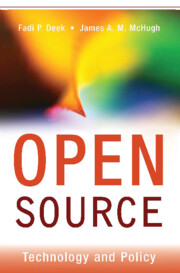Book contents
- Frontmatter
- Contents
- Preface
- Acknowledgments
- 1 Introduction
- Section One Open Source – Internet Applications, Platforms, and Technologies
- Section Two Social, Psychological, Legal, and Economic Aspects of Open Source
- 5 Demographics, Sociology, and Psychology of Open Source Development
- 6 Legal Issues in Open Source
- 7 The Economics of Open Source
- Section Three Free Software: The Movement, The Public Sector, and the Future
- Glossary
- Subject Index
- Author Index
- References
7 - The Economics of Open Source
Published online by Cambridge University Press: 16 January 2010
- Frontmatter
- Contents
- Preface
- Acknowledgments
- 1 Introduction
- Section One Open Source – Internet Applications, Platforms, and Technologies
- Section Two Social, Psychological, Legal, and Economic Aspects of Open Source
- 5 Demographics, Sociology, and Psychology of Open Source Development
- 6 Legal Issues in Open Source
- 7 The Economics of Open Source
- Section Three Free Software: The Movement, The Public Sector, and the Future
- Glossary
- Subject Index
- Author Index
- References
Summary
This chapter looks at open source development from an economic and business point of view. We have two objectives. One is to understand the economic matrix in which open source development operates, what characteristic economic factors affect its viability, and what proven business models have been established. The other objective is to consider some of the classic motivational questions about why people do open development from an economic perspective. Some standard economic factors we consider are the influence of vendor lock-in, network effects (or network externalities), the total cost of use of software, the impact of licensing on business models, the potential for customizability for open source versus proprietary products, implications of complementary products, and the effect of commoditization. We also examine some of the successful open source business models that have evolved over time. The longstanding question about open business models is basically how can people make money off a product that is given away for free? Who pays for the cost of developing this software? We consider various approaches that have proved successful, including dual licensing, consultation on open source products, provision of open source software (OSS) distributions and related services, and hybrid business models like the use of open source for in-house development or horizontally in a strategic synergistic combination with proprietary products such as in the case of IBM's involvement with the Apache Foundation and Linux.
- Type
- Chapter
- Information
- Open SourceTechnology and Policy, pp. 265 - 294Publisher: Cambridge University PressPrint publication year: 2007



